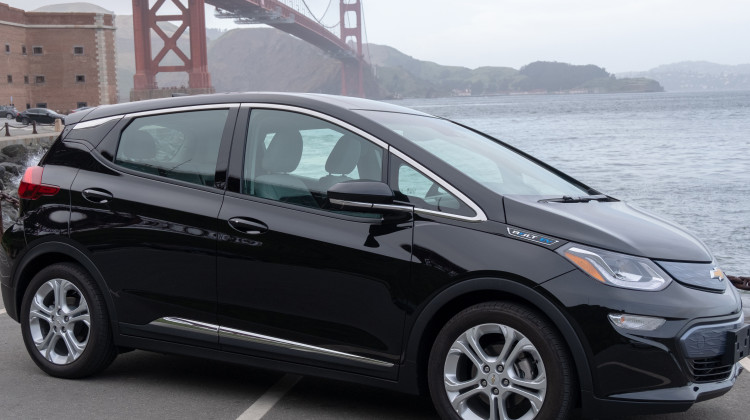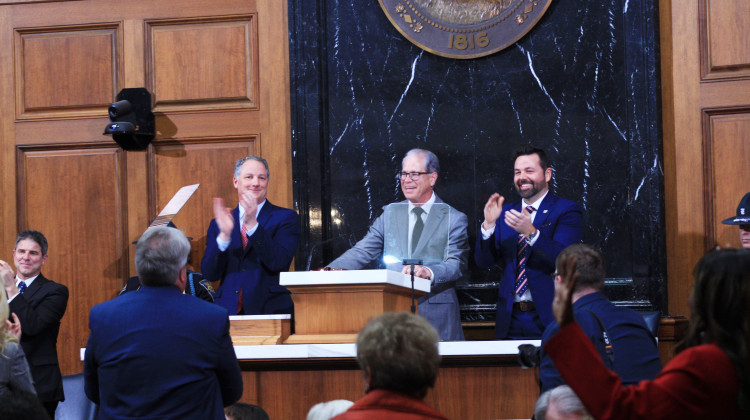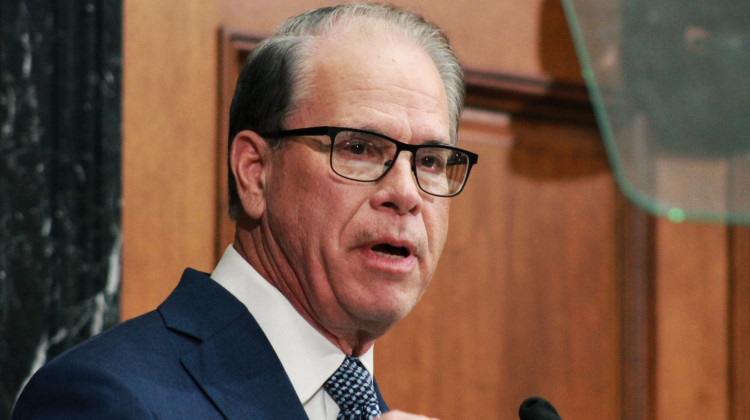
Government mandates in the U.S. and internationally are a primary force driving the transition to EVs.
Gregory Varnum/Wikimedia CommonsThere are some immediate concerns in contract negotiations between the United Auto Workers and the “big three” U.S. automakers: wages, paid time off and plant closures. The auto manufacturers — Ford, General Motors and Stellantis — must present contract offers that satisfy the union by midnight Thursday to prevent a possible strike.
But there are also some union and company demands that represent worries about the future beyond this four-year contract.
Some local and national UAW leaders are concerned members will lose jobs as companies transition to making more electric vehicles (EV) and fewer internal combustion engine vehicles. A model created by researchers at Indiana University and MIT in 2022 found the EV transition could create hundreds of thousands of jobs in Indiana and surrounding states by 2050, but also “could result in significant job loss without the right supportive policies.”
Government mandates in the U.S. and internationally are a primary force driving the transition to EVs, said Yen Chen, principal economist at the Center for Automotive Research based in Ann Arbor, Michigan.
Electric vehicles take fewer components to produce. Most, for example, have much simpler transmissions and engines. The Chevy Bolt, one of General Motors’ flagship EVs, had three moving parts in its motor, according to a 2017 teardown analysis by investment firm UBS. By comparison, UBS found a 4-cylinder ICE engine in a Volkswagen Golf had 113 moving parts.
Ford told shareholders in 2017 that its EV production requires 30 percent fewer hours of labor.
So as companies start talking about making almost all or at least a significant portion of their vehicles electric within the next decade, a question arises: What happens to full-time workers who are no longer needed?Denny Butler is vice president of UAW Local 685, which represents workers in five Stellantis ICE plants in Kokomo. Two of those plants are transmission plants, another part that is made significantly less complex in EVs.
“It's going to do away with the majority of the transmission work we do here in Kokomo and this is the transmission capital of the world,” Butler said. “They have to realize … the number of people that they're going to affect. I totally get that, you know, electrification is coming. Our infrastructure is not ready for it. And I think, here locally, there's a lot of people that take pride in their work.”
To ensure there are more jobs available in the EV future, the UAW has included an unusual demand in these contract negotiations: 32-hour work weeks with full-time pay.
Derek Cronin is president of UAW Local 440, which represents workers at a General Motors aluminum casting plant in Bedford, Indiana.
“We're a plant that works, six days a week routinely. And so the idea that you would get 40 hours pay for 32 hours worked was refreshing,” Cronin said. “I think it could definitely be realistic. We still do have members that would want the overtime, that would want to work the 56, 68 hours a week. We have those members for sure.”
Cronin said he’s not as worried about the EV transition affecting his plant as his counterparts in Kokomo, as they can easily transfer the same production work to EVs and have already started casting some aluminum parts for them.
Gary Quirk, president of Local 685 in Kokomo, said he supported the idea of a shorter workweek as well, especially in the context of the EV transition. But he doesn’t think it’s a top priority for the contract.
One of Stellantis’s early contract proposals to the UAW included a list of demands like cuts to pensions, health care and the ability to make unilateral changes to the contract during its four-year term without a vote from UAW members. The union’s national president, Shawn Fain, threw the proposal in the trash during a Facebook livestream.
The reason Stellantis gave for those demands, according to Reuters which obtained a copy of the proposal, was to “find ways to reduce the overall fixed cost structure of our business" due to “government electric vehicle rules.”
Local 685 President Gary Quirk said he's frustrated by politicians nationally and locally who support policies pushing electrification. National UAW leaders have expressed similar frustrations, creating some tension for President Joe Biden as his administration seeks to push labor-friendly policies and simultaneously cut carbon emissions that lead to climate change.
“It's definitely going to affect Kokomo, Indiana,” Quirk said. “If people don't have nothing to fall back to, other than $16, $18 an hour jobs, it's going to affect the economy, not even just locally.”
In April, the AP reported Stellantis offered buyouts to more than 30,000 U.S. blue collar workers and 2,500 salary workers, citing electrification as the reason for those cuts.
GM is taking a different approach, at least publicly. The company has said its “goal is to have a role for everyone who wants to be part of the company’s journey” into an “all-electric future.”
Amber Kidd works at GM’s Fort Wayne Assembly Plant. She said she hopes that is the case.
“Anything that will keep our plant open we’ll do,” Kidd said. “I don’t want to have to transfer. The fear of cutting a shift because we don’t need as many people is terrifying.”
Is it possible for GM to keep all its workers and remain profitable in an “all-electric future” where it doesn’t need so many hours of labor? Kind of, said Yen Chen at the Center for Automotive Research.
“So they will take everyone, but what they don't tell you is how many more new hires they're going to hire in the future,” Chen said. “They could take the existing workers. They are all there. Once the worker retires, they don't replace them. And [the company] still keep[s] their promise.”
Chen said he is unsure that the union will be able to get automakers to agree to its demand for a 32-hour work week.
Not everyone is as concerned about the EV transition in Indiana. Rich LeTourneau is shop chairman for UAW Local 2099, which represents Amber Kidd and other workers at the Fort Wayne GM pickup truck assembly plant.
“I don't see that there's an urgency to move over right now because the market's going to drive it,” LeTourneau said. “Now, if the market goes crazy and it looks at the EVs as the ticket, then I think you may see some changes. But I don’t think you're going to see that anytime soon.”
It might be possible for GM not to electrify its vehicles at the speed it says it will, Chen from the Center for Automotive Research said. Medium- and heavy-duty trucks, he said, will likely be last to go.
READ MORE: Electric vehicle stakeholders discuss access, state of EV infrastructure
Join the conversation and sign up for the Indiana Two-Way. Text "Indiana" to 73224. Your comments and questions in response to our weekly text help us find the answers you need on statewide issues.
But GM is already working on rolling out a line of light-duty electric trucks, including the Chevy Silverado EV. And Chen said it's likely GM won't have a choice on the rest of its truck line eventually.
“The current EPA proposed greenhouse gas emission requirement may force them to put all their pickup trucks into electrification,” he said. “The greenhouse gas emission is based on the per vehicle basis. So either you pass the greenhouse gas emission or you don't. And every vehicle in the United States needs to pass the EPA certificate in order to be legally sold and drive on the road.”
Despite job losses on the horizon, it is possible that the EV transition will create some new jobs in battery manufacturing, for example. GM and Stellantis are each building battery plants in Indiana. But those plants represent different problems for the union and potentially the state, Chen said.
“That could be an issue for local government and for the state government when considering the incentives [for] battery plants,” Chen said. “Indiana is one of the leading state that has transmission plants and those transmission plants, they're hiring a lot more workers than the battery plan has. And it could be a net loss in that regard.”
GM is also part of a “joint venture” with Samsung SDI that will open an Indiana plant by 2026 just west of South Bend, in New Carlisle, to build electric vehicle batteries.
While the plant — and other existing “joint venture” plants in nearby states — will primarily supply EV batteries for GM vehicles, the company argues the plants’ workers should not be part of the same national contract because they’re technically owned by separate companies.
The UAW and some members of Congress disagree. U.S. Sen. Sherrod Brown (D-Ohio) called the company’s argument “excuses from a bunch of overpaid, out-of-touch executives.”
Stellantis is also building a “joint venture” battery plant with Samsung SDI in Kokomo. Gary Quirk, the UAW Local 685 president, said he plans to work to unionize the plant once it's up and running in 2027.
“They have to be up to the same wages and things that we're used to now,” he said. “I mean, we cannot go to the bottom. Some of your battery plants are $16 an hour. And in seven years you get $21 an hour.”
In an emailed statement, a spokesperson for Stellantis said “the joint venture with Samsung SDI provides us with access to innovative, high-quality technology that will meet the needs of our customers as we transition to an electrified future. We respect the right of the UAW to organize future hourly employees at our joint venture facilities and believe that those future employees have the right to decide their representational status. The joint venture intends to offer very competitive wages and benefits while making the health and safety of its workforce a top priority.”
Adam is our labor and employment reporter. Contact him at arayes@wvpe.org or follow him on Twitter at @arayesIPB. Contact WBOI's Tony Sandleben at tsandleben@wboi.org or on Twitter at @tony_WBOI.
9(MDAyMzk1MzA4MDE2MjY3OTY1MjM5ZDJjYQ000))
 DONATE
DONATE






 Support WFYI. We can't do it without you.
Support WFYI. We can't do it without you.